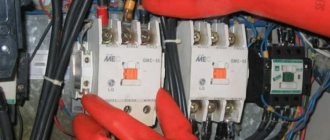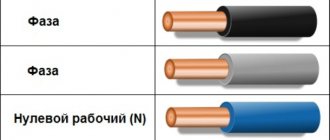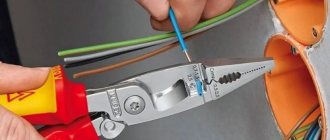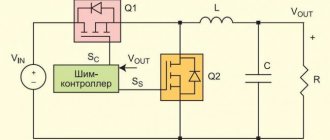Test periods for electrical protective equipment
The use of electrical protective equipment in electrical installations is one of the main measures to protect operating personnel from electric shock.
Protective equipment performs its insulating function only if it is intact, technically serviceable and has sufficient dielectric strength for the voltage class for which it is used. In order to timely identify defects and reduce the dielectric strength below the permissible level, periodic electrical laboratory tests of protective equipment are carried out. In this article we will consider the timing of testing electrical protective equipment used to perform work in electrical installations.
Dielectric gloves are tested at high voltage once every six months.
Periodic testing of gloves does not guarantee that they will be suitable for use throughout their entire service life, since dielectric gloves may be damaged during use.
If gloves are torn or severely damaged, they are completely removed from service. If the damage is insignificant, then this protective equipment is submitted ahead of schedule for periodic inspection in order to determine the possibility of their further operation.
While visible damage to gloves can be detected during the next inspection, a minor puncture cannot be visually detected. The presence of even a slight puncture indicates that dielectric gloves are no longer suitable and their use is dangerous to the lives of personnel.
Therefore, before each use of dielectric gloves, it is necessary to check them for tightness, that is, for the absence of punctures. To do this, dielectric gloves begin to be rolled from the edge towards the fingers and, holding the twisted edge, press on the glove to make sure that no air escapes.
It should also be taken into account that if dielectric gloves are not stored correctly, when they were exposed to direct sunlight for a long time, were contaminated with lubricants, or were stored near various destructive chemicals, the dielectric strength of the gloves may be reduced. In this case, they must be submitted for testing, regardless of whether the deadline for the next test has come or not. The same applies to other protective equipment made from dielectric rubber - boots and galoshes, as well as insulating mats, caps, and pads.
The test period for dielectric boots is once every three years, and for dielectric galoshes - once a year. These protective equipment must be checked before each use to ensure they are not damaged. If visible damage is detected, this protective equipment is submitted for an extraordinary inspection to determine suitability for further use.
Voltage indicators, clamp meters and measuring rods
Voltage indicators (including indicators for checking phasing), clamps and rods for measuring current, voltage and power, light signal indicators for damage to cable lines, are tested once a year. Before use, the voltage indicator (measuring rod, clamps, etc.) is checked for integrity and operability. If visible damage to the insulating part is detected, as well as if there is a malfunction, this protective equipment is submitted for repair and early testing.
Insulating rods, clamps, rods for installing grounding
Operating rods and insulating clamps of voltage classes up to and above 1000 V are tested once every two years. At the same frequency, rods are tested for installing portable grounding in electrical installations of voltage class 110 kV and higher, as well as insulating flexible elements of portable grounding of rodless designs for electrical installations of 500 kV and higher.
Insulating rods for installing grounding connections on equipment up to 35 kV inclusive are not subject to periodic testing. Suitability for use is determined by visual inspection for damage before each use and during the next scheduled inspection of protective equipment.
Insulating caps, covers, hand tools
Insulating pads, caps and other insulating means for performing live work (ladders, insulators, etc.), insulating parts of hand tools are tested once every 12 months.
When performing work under voltage, it is necessary to periodically check the integrity of the insulating means, since during the work the integrity of the insulating elements may be compromised.
Insulating mats (stands)
Rubber insulating mats and dielectric supports are not subject to testing. These protective equipment ensure their insulating properties in the absence of moisture, contamination and damage to the insulating part - the surface of the dielectric mat or stand insulators.
Portable protective grounds
Portable grounding connections are not subject to testing. An indication of their suitability is the absence of damage to the conductors (no more than 5% damage is allowed), as well as the operability of the clamps - they must ensure reliable contact of the portable grounding with the live parts of the electrical installation equipment, as well as with the grounding connection point.
Accounting and periodic inspection of protective equipment
In order to ensure that protective equipment is always tested and ready for use, it is necessary to organize their recording and periodic inspection.
To record and control the condition of protective equipment, a special log “registration and storage of protective equipment” is kept, in which for each protective equipment its inventory number, the date of the previous and next test are recorded. To timely identify faulty or subject to next testing of protective equipment, periodic inspections are organized. The frequency of inspections is determined by the management of the enterprise. The date of the periodic inspection and the result of the inspection are recorded in the protective equipment log.
Test of strength
Testing electrically insulating gloves is a necessary measure during their use. Such a check (verification period) is carried out once every six months (the frequency of the check depends on the marking “Ev” and “En”).
Scheme for testing mittens, boots and galoshes for strength:
- 1 – test transformer;
- 2 – switching contacts;
- 3 – shunt resistance;
- 4 – gas-discharge lamp;
- 5 – throttle;
- 6 – ammeter (mA);
- 7 – spark gap;
- 8 – container with water.
Before starting the test, it is necessary to set the switch from the corresponding contacts to position A. This is necessary in order to establish the absence (presence) of a breakdown using signal lamps. If there is no breakdown, then the switch is moved to position B and the electric current that passes through the gloves is measured. If the passing current exceeds the norm, then such gloves are rejected. Those mittens that were rejected are strictly prohibited from being used for work! Since they will be unable to protect a person from electric shock. When the test is over, the leggings are dried.
The verification scheme may be slightly changed, but the essence remains the same. Now we will look at another test method, where we will tell you how to use the installation for testing gloves.
So, the dielectric material of the gloves can be checked using an example: water is poured into the container of the device under test and into the sample (gloves). Its temperature ranges from 10 to 40 degrees Celsius. The distance from the edge of the glove to the water should not exceed 55 millimeters. The edges of the gaiter and containers must remain dry.
The voltage that is supplied to the container body and the electrode that is lowered inside the glove has its own requirements and is equal to 6 kV. The test lasts one minute. The milliammeter should show the value of the current that passes through the guards - 6 mA.
The dielectric material from which the mittens are made must dry out after testing. To do this, they are placed in a special tank, such as shown in the photo below:
After drying, a test stamp must be placed on the electrically insulating gloves, which must indicate the date of use of the protective gloves (the date until which the material is good for). For example:
The stamp must be clearly visible and must be applied with indelible paint. Then it is necessary to enter information into a log indicating the testing of protective equipment. The log looks like this:
After completing all the listed procedures, if there is such a need, a protocol is issued indicating the inspection of electrical insulating leggings. A sample protocol looks like this:
We also recommend watching a video that clearly demonstrates the technology for testing dielectric gloves:
Types of dielectric gloves for electricians
Rubber or latex is usually used for production. The size of the gaiter is selected in such a way that it is comfortable to work in them. If dielectric gloves are intended to be used at subzero temperatures outside, the width should be larger (so that knitwear can be worn under workwear).
The following types of dielectric gloves are available:
- two-fingered and five-fingered;
- suture and seamless dielectric gloves.
In electrical installations, you can use insulating gloves marked “Ev” and “En”:
- “Ev” – the product protects the skin from voltages exceeding 1 kV (as an auxiliary protective agent);
- “En” - used as the main protective agent for currents with voltages up to 1 kV.
Characteristic
They are used in installations in which the electric current does not exceed 1000 (V). The main substance in the composition is high-quality rubber, or latex.
Dielectric gloves can be seamless or, conversely, with a seam; there are also five-fingered and two-fingered options. As for the size of the glove, it is standard - it is 350 mm. The width should be much larger than the hand so that the worker can wear a regular glove under the special one; this is necessary so that the person’s hands do not freeze while working.
The glove sleeve must be worn strictly over clothing; tucking or tucking insulating gloves is strictly prohibited. Workers' clothing should not prevent them from wearing gloves. They should fit freely on your hand.
Principles of testing and testing periods for dielectric gloves
Safety regulations require testing of dielectric gloves every six months. Testing is carried out in laboratory conditions: first, the pair is subjected to a load of 6 kV for 60 seconds. If the products are suitable for use, they conduct no more than 6mA; if the material conducts more current, the gaiter is unsuitable for use as electrical protection.
- Electrically insulating dielectric gloves are placed in a metal container with warm or slightly cool (not lower than 20 C) water. In this case, the gloves are not completely immersed - the top should look 45-55 mm above the surface. This is necessary so that electrodes can be placed inside the mittens. The material above the water (as well as the walls of the tank that are not filled with liquid) must be dry.
- One of the transformer contacts is connected to the container, the other is grounded. An electrode grounded using a milliammeter is immersed in the gloves. Thanks to this method, it is possible not only to assess the integrity of the material, but also to test whether electric current flows through the product.
- The load comes from transformer equipment, which is connected by one wire to the tank, and by the second to a two-position switch. The first test method: transformer-gas-discharge lamp-electrode chain; second method: transformer-milliammeter-electrode chain.
Several pairs can be tested at once, provided that it is possible to check the load passing through each product. After testing, the leggings are thoroughly dried.
The frequency of inspection of dielectric gloves must be strictly observed, since when working with currents up to 1 kV this is often the only protection against possible electric shock.
How to check products
The latex coating is exposed to high voltage (6 kV). If the product conducts a current of more than 6 mA through itself, the gloves are written off and are prohibited from being used, as this is dangerous to human life. High-quality and timely testing of dielectric gloves is extremely necessary, since due to the damaged surface of the product, a person who carries out repair or any other work in electrical installations is exposed to serious danger.
Testing rubber gloves and other similar products is the key to human safety and health. Also, by testing on gloves, defects can be identified. It is always important to remember that testing should be carried out regularly. As mentioned, rubber gloves should be checked every 6 months. And if the product has not been checked for more than 6 months, it is strictly prohibited to use it in electrical installations.
Requirements for rubber gloves for electricians
Dielectric gloves for currents up to 1000V and more than 1 kV have two layers of different colors. There is a number marking on the outside.
When releasing each batch, the following data must be indicated:
- Product name;
- Date of manufacture;
- Number of claws in the batch;
- Type and marking;
- Product mark;
- Expiration date and warranty.
Before use, tests are carried out on the gaiters, the results of which are noted in a special form. First, one pair is taken. If the product does not pass testing, 2 other pairs are taken from the same batch, but more in-depth testing is carried out on them. If they pass the test, it expands the usability of the entire batch; if not, the dielectric gloves are acceptable, that is, they do not meet the requirements.
If goods are transported from one climate zone to another, the batch is left for a day at room temperature and only then unpacked. During storage, dielectric gloves should not be exposed to ultraviolet rays (sunlight), and the packaging should be located at a distance of at least 1 m from heating and heating devices.
Service life of dielectric gloves
If the storage rules are followed, dielectric gloves usually last 1 year or more (if there is a periodic inspection of the product - once every six months). The warranty period must be indicated on the packaging.
If safety precautions are not followed, a person wearing gloves may receive an electric shock, which can cause muscle spasms, difficulty breathing, and even death.
Some people's skin does not conduct electricity, so when they receive an electric shock, they do not feel any discomfort at first. However, there are signs that indicate that an electric shock has occurred and medical attention is needed. This:
- A sharp fall by an employee if he stood next to electrical appliances or electrical equipment;
- Deterioration of vision (the eye does not respond to light), speech understanding;
- Stopping breathing;
- The occurrence of convulsions, loss of consciousness.
Electric shock may cause a burn on the skin. However, if it is not there, this does not mean that everything is fine: the current may not affect the outer skin, but cause problems with breathing or heart.
It is important to immediately remove the person from the source of the electric shock, since he himself will not be able to remove his hand from the wire. To do this, you cannot use your hands; you need to use an object that does not conduct electricity. Then you need to check whether the person has a pulse and breathing. If not, you need to immediately call an ambulance and begin resuscitation (artificial respiration). It is also important to find the place where the current entered, cool it with water for 10-15 minutes, and wrap the damaged areas of the skin with clean bandages.
What are gloves?
The main device that can prevent electric shock when performing any work is, of course, dielectric gloves. Such products are considered the main means of protection if the voltage does not exceed 1000 volts. If this indicator is higher in the network, gloves are considered additional means of protection.
In any case, it is strictly prohibited for an electrician to work without gloves. In addition, such products must be periodically checked for integrity.
Rubber for the manufacture of such personal protective equipment is selected taking into account the requirements of GOST. Dielectric gloves, of course, must be as reliable as possible. In most cases, electrician gloves do not have seams. That is, products of this type cannot break up at the most inopportune moment.
Sometimes such gloves still have a seam. But in products of this type it is necessarily covered with sheet rubber. Only latex dielectric gloves according to GOST cannot have a seam. Compared to rubber, this material cannot be considered too reliable in terms of ruptures and punctures.
Of course, dielectric protective equipment must, among other things, be as durable as possible. For example, according to GOST, dielectric latex gloves, since they are not considered too reliable, cannot be used for working with high voltage networks. In this case, you should choose durable rubber.
In addition to rubber and latex, manufacturers, as already mentioned, sometimes use silicone to make personal protective equipment. Gloves of this type are even more durable than rubber gloves and do not conduct electricity at all. Therefore, products of this type are usually used for operation in networks with very high voltage.
The shape of the electrician's glove resembles ordinary rubber gloves with five fingers. Electricians usually call them dielectric gloves. Sometimes, when performing various types of work, dielectric gloves with two or three fingers can be used.
In any case, domestic products of this type are marked during production as “Ev” or “En”. Any other rubber gloves produced in Russia cannot be considered dielectric. That is, it is impossible to use simple rubber accessories that are not properly marked where protection against current is needed.
Features of using electrically insulating gloves
Before use, dielectric gloves should be inspected, paying attention to the absence of mechanical damage, contamination and moisture, and also check for punctures by twisting the gloves towards the fingers.
Before putting on dielectric gloves, it is necessary to inspect them, focusing on the following points:
- Verification stamp must be present
- The product must not have any mechanical damage
- Leggings should not be dirty or wet
- There should be no punctures or cracks
Almost everything here is clear and easy to evaluate visually, but how to check dielectric gloves for punctures? To do this, you need to twist the gaiters towards your fingers - the cracks will immediately become noticeable.
During use, the edges of the gloves should not be turned up. To protect against mechanical stress, you can wear leather or canvas items on top.
From time to time it is recommended to wash the used pair in a soda solution (ordinary soapy water can be used). The gloves are then dried.
Important: If dielectric gloves meet the protective properties, they can be used for six months, until the next inspection. However, before each use you need to check their condition. If cracks, mechanical damage, etc. are found, this protective agent cannot be used.
How to test dielectric gloves
Any work with electricity is quite dangerous for both beginners and experienced electricians. In this area of work, it is very important to follow safety precautions, otherwise everything can end very badly. An electrician’s tools should always be insulated and periodically checked for damage, breakdowns, and so on, because just one faulty device can have serious consequences.
In addition to tools, electricians use personal protective equipment against electric shock. This list includes rubber gloves, galoshes, and mats. All these things are made of rubber, specialized for the needs of working with electricity. This type of rubber differs from conventional rubber in its greater elasticity and also in its fairly high electrical strength.
However, even such rubber is susceptible to destruction from excess heat, improper storage, mechanical damage, and so on. It is because of this that dielectric gloves should be periodically checked for malfunctions.
This article will help you learn how dielectric gloves are tested, as well as the frequency of testing dielectric gloves .
What are gloves made of and where are they used?
Dielectric rubber gloves are used to protect human hands when carrying out repair or other work in electrical installations. Each product must have special markings.
The main advantages of this protective agent:
- The gloves are moisture resistant;
- The material itself is durable, so it is quite difficult to simply damage a dielectric glove;
- The product is not subject to deformation;
- Gloves are made of special rubber - latex;
- Gloves help protect a person from electric shock.
Based on safety regulations, dielectric gloves should be tested once every 6 months. Strength testing of such products is carried out in specially designated laboratories, where specialists, using special equipment, conduct a series of tests and checks.
Frequency of testing dielectric gloves
Dielectric gloves must be tested at least once every six months. It doesn’t matter whether they were stored in a warehouse all this time, or whether they were actively used in work. Such testing periods for dielectric gloves allow timely detection of damage to dielectric gloves, and also allow them to determine their further suitability for use.
Do new dielectric gloves need to be tested ? Why test dielectric gloves if you can just throw away the old ones and buy new ones? Nevertheless, rules are rules, there is no escape, especially in large organizations, each purchase costs a pretty penny, but you have to work. Therefore, even new protective equipment must be tested before being put into operation.
Test method for dielectric gloves
As has already become clear, dielectric gloves that do not have mechanical damage are subjected to special electrical tests. For this purpose there must be a specially equipped laboratory. Electrical testing of dielectric gloves must be carried out in water, which allows one to achieve better test results, since in this case even minor damage can be detected.
To fully test dielectric gloves
- 1. Bath with water
- 2. Electrical installation (laboratory)
The testing process itself is quite simple. Take the glove and place it in the bath, then fill the bath with water. The inside of the gloves should also be filled with water to the same level as the outside. The glove should be positioned in the water so that its protruding edges are dry by 45 - 55 mm, i.e. The water level, both outside and inside, should be at least 4.5 - 5 cm from the edges.
Please note: the bath must be metal, if there is no metal bath, use any metal vessel you can find, the main condition is that you can put a glove in it. The temperature of the water in the vessel must be at least +25 degrees Celsius.
After this, one of the transformer terminals must be connected to our metal bath and must be grounded. And inside the glove we immerse an electrode connected through a milliammeter to the second terminal of the transformer.
What voltage do dielectric gloves experience? The voltage used in the tests must be 6 kV. In this case, the value on the milliammeter should not exceed 6 mA. The duration of such a test is at least 60 seconds.
Pay special attention to the following: when starting the test, the switch must be in position A. This position will allow you to check for breakdowns in the dielectric glove using special warning lamps. If there is no breakdown, the switch is moved to position B. Directly in this position, the amount of current flowing through the dielectric glove is measured.
A small explanation of the diagram:
- 1 – Installation transformer
- 2 – Switch
- 3 – Milliammeter
- 4 – Gas discharge lamp with shunt resistance
- 5 – Metal bath with water
- 6 – Electrode
If the signal lamps indicate a breakdown, the tests are stopped and the entire circuit is switched off. If the glove passes a current exceeding a value of 6 mA, the tests also end and the glove is rejected .
| All electrical installation personnel have to pass exams. And during exams, questions are often asked about the methodology and timing of testing dielectric gloves. How easy is it to remember all these numbers? Everything is very simple, you need to remember four sixes (6x4): |
| 1. Frequency – once every 6 months |
| 2. Voltage – 6 kV |
| 3. Allowable current – 6 mA |
| 4. Duration – 60 seconds |
If, as a result of testing, dielectric gloves are found suitable for use, they must be thoroughly dried. After this, a test stamp is applied to the gloves and they are sent for storage and subsequent use.
By the way, using the same method and scheme, dielectric galoshes and boats are tested.
What to do if the gloves do not pass the test
If for some reason the gloves did not pass the test and were rejected, then they should be dealt with as follows. The stamp is crossed out with red paint (if it was there, if it wasn’t, just cross out the gloves crosswise). After this, they are removed from service; storing unsuitable personal protective equipment is strictly prohibited.
There is a special instruction that regulates the procedure for testing dielectric rubber products, as well as their future fate. The laboratory conducting such tests should have a logbook in which all results are recorded.
Usually it is called “Test log of protective equipment made of dielectric rubber (gloves, boots, dielectric galoshes and insulating pads)” in accordance with Appendix 2 “Instructions for the use and testing of protective equipment used in electrical installations SO 153-34.03.603-2003”.
{SOURCE}
Features of testing
Gloves are designed to protect hands from electric shock when working in electrical installations up to 1000 V as the main electrical protective equipment, and in electrical installations above 1000 V as an additional one. In electrical installations, seamless gloves made of latex, natural rubber, or gloves with a seam made of sheet rubber, made by stamping, can be used. In electrical installations, it is allowed to use only gloves marked with the protective properties En (for protection against electric current with voltages up to 1000 V). The length of gloves must be at least 350 mm. For testing, a high-voltage installation is used; gloves are placed in a bathtub filled with water.
When testing, dielectric gloves are immersed in a metal vessel with water having a temperature of 25 + 10 degrees Cº, which is also poured inside these products. The water level both outside and inside the products should be 50 mm below the top edge of the gloves. The exposed edges of the gloves must be dry. One terminal of the test transformer is connected to the vessel, the other is grounded. An electrode connected to ground through a milliammeter is lowered inside the gloves. A schematic diagram of testing dielectric gloves is shown in the figure:
Rice. Schematic diagram of testing dielectric gloves.
1 – test transformer; 2 – throttle; 3 – milliammeter; 4 – spark gap; 5 – bath with water.
After verification, only those PPE that pass a current of no more than 6 mA can be used. Often during procedures, manufacturing defects are revealed. In this case, the PPE is disposed of.
It is worth considering a number of nuances when using:
- Only clean gloves may be used;
- Dust and dirt are excellent conductors, so dirty products create a high level of danger during operation;
- To eliminate the problem, gloves are thoroughly disinfected and cleaned with soap and soda.
Only dried devices can be used.











